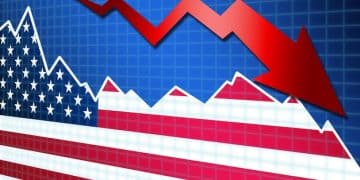Retail Sales Report: Understanding Consumer Spending Trends and Economic Outlook in the US

Retail Sales Report is a crucial barometer of the US economy, offering insights into consumer spending habits, emerging trends, and the overall economic health, enabling businesses and investors to make informed decisions.
Understanding the fluctuations in the retail sales report: consumer spending trends and economic outlook is critical for businesses and investors alike. This report provides a snapshot of consumer behavior, reflecting broader economic conditions in the United States.
Decoding the Retail Sales Report: An Overview
The retail sales report is a monthly economic indicator released by the U.S. Census Bureau. It measures the total receipts at stores that sell merchandise and related services to final consumers. This data is vital for analysts, economists, and business owners as it reflects consumer confidence and spending habits.
Grasping the nuances of this report helps in understanding the pulse of the economy. Here, we’ll explore its importance and the key areas it encompasses.
Significance of the Retail Sales Report
Retail sales are a major component of consumer spending, which accounts for a significant portion of the U.S. Gross Domestic Product (GDP). Therefore, the retail sales report serves as an early indicator of economic performance. A strong report typically suggests that the economy is expanding, while a weak report may signal a slowdown or recession.
Key Components of the Report
The report provides data on various retail sectors, including:
- Motor vehicle and parts dealers
- Food and beverage stores
- Clothing and accessory stores
- Electronics and appliance stores
By looking at these categories, you can identify trends in specific sectors and understand where consumers are spending their money.
Ultimately, the retail sales report gives insight into the health and direction of the overall economy. Monitoring this data helps in making informed financial and business decisions.

Analyzing Consumer Spending Trends
Consumer spending drives a significant portion of the US economy, and the retail sales report provides valuable data to analyze these trends. By examining the categories that are performing well and those that are struggling, you can discern changes in consumer preferences and economic conditions.
Let’s delve deeper into how to interpret these spending patterns.
Impact of Economic Factors on Spending
Various economic factors influence consumer spending, including:
- Employment rates: Higher employment typically leads to increased spending.
- Inflation: Rising prices can reduce purchasing power and shift spending habits.
- Interest rates: Lower interest rates may encourage spending on big-ticket items.
Seasonal Variations in Retail Sales
Retail sales often exhibit seasonal patterns. For example:
- Holiday season: A significant surge in sales occurs during November and December.
- Back-to-school: Spending increases in late summer as families purchase school supplies and clothing.
- Summer months: Certain sectors, like sporting goods and garden equipment, see increased sales.
Understanding these patterns can help businesses prepare for fluctuations in demand and adjust inventory accordingly.
In conclusion, analyzing consumer spending trends using the retail sales report requires an understanding of both broad economic factors and seasonal variations. This comprehensive approach can provide valuable insights for businesses and investors.
The Correlation Between Retail Sales and Economic Growth
The retail sales report isn’t just a reflection of past spending; it’s also a potential indicator of future economic growth. A strong correlation often exists between increased retail sales and overall economic expansion, making the report a crucial tool for forecasting.
Here’s how retail sales can signal economic trajectories.
Retail Sales as a Leading Indicator
As consumer spending is a key driver of GDP, rising retail sales often precede broader economic growth. This makes the retail sales report a leading indicator, meaning it can provide an early signal of economic trends before they become apparent in other data.
Interpreting Positive and Negative Signals
Here’s how to interpret retail sales data:
- Positive signals: Consistent increases in retail sales often indicate strong consumer confidence and a healthy economy.
- Negative signals: Declining retail sales may suggest weakening consumer confidence and a potential economic slowdown.
Other Economic Indicators to Consider
While retail sales are important, it’s essential to consider them in conjunction with other economic indicators, such as unemployment rates, inflation, and manufacturing data. Looking at a range of data points provides a more comprehensive view of the economic landscape.
Ultimately, the retail sales report is a valuable piece of the economic puzzle. When analyzed alongside other indicators, it can provide a clearer picture of economic growth and potential challenges.

Impact of E-Commerce on Retail Sales Data
E-commerce has dramatically changed the retail landscape, and it’s crucial to understand how online sales are reflected in the retail sales report. The rise of online shopping has significant implications for traditional brick-and-mortar stores and the overall interpretation of sales data.
Let’s explore how e-commerce influences retail sales statistics.
Accounting for Online Sales
The retail sales report includes data on both brick-and-mortar and online sales. However, the increasing share of e-commerce means analysts must pay close attention to the online component to accurately assess consumer spending trends. Rapid growth in e-commerce can mask declines in traditional retail sectors.
The Shift from Brick-and-Mortar to Online
The shift to online shopping is evident in the changing composition of retail sales:
- Decline in department stores: Traditional department stores have seen declining sales as consumers increasingly shop online.
- Growth in online retailers: Online retailers like Amazon have experienced substantial growth, capturing a larger share of the retail market.
Challenges in Data Collection
Collecting accurate data on e-commerce sales presents challenges, including:
- Defining online retail: Determining which online transactions qualify as “retail sales” can be complex.
- Tracking cross-border sales: Sales from international e-commerce platforms may not be fully captured in the report.
Understanding the impact of e-commerce is essential for accurately interpreting the retail sales report. By considering the online component, analysts can gain a more nuanced understanding of consumer spending trends and the overall health of the retail sector.
In summary, keep in mind that e-commerce significantly reshapes the retail landscape data, introducing new challenges and dynamics to retail sales. Paying attention to these changes is crucial when interpreting this economic indicator.
Factors Influencing Retail Sales: A Deeper Dive
Several key factors can significantly influence retail sales, each playing a unique role in shaping consumer spending patterns. Understanding these factors is essential for a comprehensive analysis of retail sales data and its implications for the economy.
Let’s explore some of the most critical influencers.
Consumer Confidence and Sentiment
Consumer sentiment plays a crucial role in driving retail sales. When consumers are optimistic about the economy and their financial prospects, they are more likely to spend money. Conversely, when confidence is low, they tend to cut back on discretionary spending.
Employment and Wage Growth
Employment rates and wage growth directly impact consumer spending. Higher employment and rising wages generally lead to increased disposable income, which fuels retail sales. The retail sales report should be analyzed in conjunction with labor market data to assess the health of the economy.
Government Policies and Fiscal Stimulus
Government policies, such as tax cuts or stimulus payments, can significantly influence retail sales. Tax cuts increase disposable income, while stimulus payments provide consumers with additional funds to spend. These measures can provide a short-term boost to retail sales, but their long-term impact depends on broader economic conditions.
The Role of Credit and Debt
Consumer credit and debt levels can also impact retail sales. Increased availability of credit can encourage spending, but high levels of debt can constrain future consumption. Monitoring consumer credit data alongside retail sales can provide insights into the sustainability of spending trends.
In sum, retail sales are influenced by a complex interplay of consumer confidence, labor market conditions, government policies, and credit dynamics. A deep understanding of these factors is essential for interpreting retail sales data accurately.
Future Outlook: Forecasting Retail Sales Trends
Looking ahead, forecasting retail sales trends requires careful consideration of evolving economic conditions, technological advancements, and shifting consumer behaviors. Predicting potential changes in retail sales can help businesses and investors prepare for future challenges and opportunities.
Let’s explore what the future might hold for retail sales.
Impact of Technological Advancements
Technological advancement, such as Artificial Intelligence (AI): is expected to influence retail sales. AI is useful as businesses use data analysis to understand consumer preferences and buying patterns and to create personalized shopping experiences.
Changing Consumer Behaviors
Understanding changing consumer behaviors is critical for forecasting retail sales trends. Key trends to watch include:
- Sustainability: Increased consumer interest in sustainable products and practices is driving demand for eco-friendly goods.
- Personalization: Consumers increasingly seek personalized shopping experiences tailored to their preferences.
Economic Forecasts and Predictions
Economic forecasts from organizations like the Federal Reserve, the International Monetary Fund (IMF), and private research firms provide valuable insights into potential retail sales trends. These forecasts typically consider factors such as GDP growth, inflation, and unemployment rates to project future consumer spending.
Staying informed about these trends and forecasts can help businesses and investors make strategic decisions and prepare for future challenges and opportunities in the retail sector.
| Key Point | Brief Description |
|---|---|
| 📊 Report Overview | Measures receipts at stores selling goods to consumers. |
| 📈 Spending Trends | Shows fluctuations and reveals consumer preferences. |
| 🌐 E-Commerce Impact | Highlights the shift from physical stores to online sales. |
| 🔮 Future Outlook | Considers economic conditions and future consumer behavior. |
Frequently Asked Questions
▼
The retail sales report is a monthly economic indicator released by the U.S. Census Bureau. It measures the total sales of goods and services in the retail sector, offering insights into consumer spending.
▼
It provides an early indication of consumer spending trends, which account for a significant portion of the GDP. It offers insights into the health of the economy and potential future performance.
▼
The report includes data on both brick-and-mortar and online sales. The increasing share of e-commerce requires a closer look at the online figures to get an accurate assessment of consumer spending.
▼
Several factors such as unemployment rates, inflation, consumer confidence, and government policies influence the spending. A balanced view from all these factors is most helpful.
▼
Retail sales is leading indicator. But combining sales data with many other elements helps to better predict the future. Combining it with other factors makes this report more useful.
Conclusion
In conclusion, the retail sales report is a compass for navigating the complex waters of the US economy. By understanding its components, analyzing consumer trends, and considering influencing factors, one can gain valuable insights into the nation’s economic landscape. Always combine results with other economic factors.





